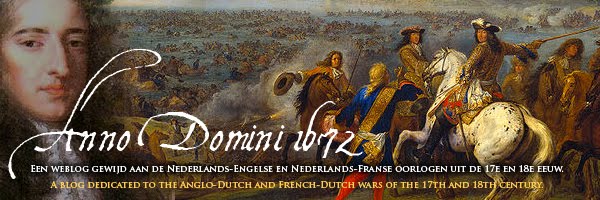
Dit fraaie schilderij (Collectie Stedelijk Museum Alkmaar) , van een onbekende maker, stelt de Kaasmarkt voor in Alkmaar. Het schilderij dateert uit 1660 en bevindt zich in het Stedelijk Museum te Alkmaar, van wie ik toestemming heb gekregen dit plaatje te plaatsen.
Het mooie van dit schilderij is dat duidelijk te zien is wat de dracht van die tijd was: we zien schippers met kniebroeken, serieuze heren in 't zwart met platte hoeden, we zien bontmutsen, dames in klederdracht en veel capes. Hoe meer je het schilderij bekijkt hoe meer details je er op ziet.
In de collectie van de Provinciale Atlas van Noord-Holland bevindt zich een ets van Romeyn de Hooghe uit 1674, die verdacht veel lijkt op dit schilderij. Qua compositie, onderwerpkeuze, de gebruikte figuren lijken de afbeeldingen zo op elkaar dat we wel moeten aannemen dat Romeyn de Hooghe leentjebuur heeft gespeeld.

Een familie met rechts onder een kinderwagen.

Twee militairen met de typische dracht uit het beginf van de jaren 1670: opvallend de korte mouwen.

Een detail wat op het schilderij wat moeilijker is te zien.
~
Many thanks to the Stedelijk Museum of Alkmaar, for letting me reproduce a picture of the painting 'View on the Weighing Building', dated 1660, unknown artist. It shows the cheese market in Alkmaar with great detail and I really love the way the artist show the people on the market with their traditonial clothing, parts of which survived up to the 20th century. Note the Burgers in the typical Holland black clothes, the capes, the fur hats and the smoking woman.
As a comparison, I show (without permission) some snapshots of an etching by Romeyn de Hooghe from 1674. The full picture can be found here, at the website of the North-Holland Provincial Atlas, and it is quite obvious that Romeyn was heavily 'inspired' by the painting. Again, a lot of detail can be seen on the etch, like the above family, the two soldiers with the typical short sleeved overcoat of the early 1670's and the writing on the building. (It's in Latin and it means 'Courage and power gave the City and People of Alkmaar the right to weigh again'. In the building goods were weighed for trade. This was one of the typical city rights, just like the right to have a market or to transfer goods.)




Als een schilderij een bepaalde populariteit kreeg, werd er vaak een prent naar gemaakt.
BeantwoordenVerwijderenHetzelfde principe deed zich ook voor mbt geschriften. Uit handelsbrieven over buitenlandse toestanden, die van hand tot hand gingen, groeide de krant.
Het schilderij over de her-inname Coevorden is weer naar de prent gemaakt, dus het ging over en weer.
BeantwoordenVerwijderenGood bread and good cheese, is good English and good Fries.
BeantwoordenVerwijderenI'll try to find a painting on bread next time...
BeantwoordenVerwijderen